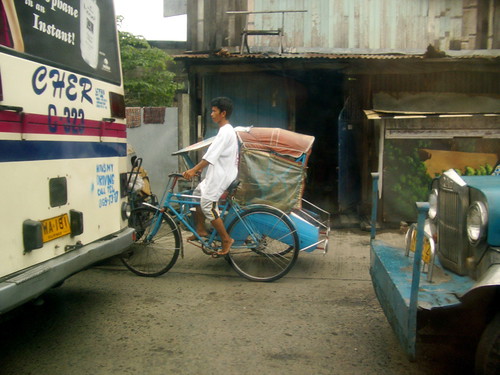I’ve told a few friends that I expect double digit inflation on food prices for 2008, but according to the Economist, we’re already there this year. The Economist’s food price index rose by a third over the last year and is at its highest level since they began the index in 1845.
Increased affluence around the world means more people eat meat, but the Economist notes also that the sudden push for ethanol means about a third of the corn crop is devoted to ethanol production. More acreage devoted to ethanol production also means less acreage for wheat, soy, and other crops. Corn is also the primary feed for cattle and chickens, so increased feed costs means we pay more for steak and chicken.
The Economist in seems to predict the exploitation of remote wilderness areas as investors pay to plow them under and build roads to access these new agricultural frontiers. We’re already seeing this in Malaysia, Thailand and Indonesia, where millions of acres of rain forest have been replaced with palm oil plantations.
Some predict that rural economies in the developing world will benefit from increased demand for biofuel crops from the west. The reality, though, seems to be different: food crops that used to sold locally are now no longer available, as farmers find it more lucrative to export their crops to the western world than to feed the local population.
This stuff is impossible to predict accurately — we know farmers are abandoning set asides, for example, and planting record acreage to cash in on the ag bonanza. If there’s a boom crop, perhaps there will be enough left over to sell to Mexican tortilla factories and the occasional food aid shipment.
It used to be that I was a little discouraged at my own attempts at conservation — I realized that imy own cutbacks only enabled somebody else to burn that much more. Now that we’re entering an era of real shortages, however, perhaps my savings will allow somebody who’s truly in need to use that resource, and I’m a little more hopeful that my example will encourage others to sacrifice a little bit of their comfortable lifestyles to enable the poor to live.

Related stories:
- Who wins, who whines when corn prices rise takes a look at the farm economy.
- Ethanol to fill an SUV can feed a person for a year.
- Feed the Greed.
- Global food crisis looms.
- Victory Garden delivered by trike in San Francisco.
Okay, enough of beating on that horse: A couple of fun links from A Boy on a Bicycle:
- Researchers find link between self esteem and materialism.
- Nice comic suggesting that Hummer owners might be compensating for something.
- Speaking of that “something,” for Heidi Klum, it was love at first site of Seal in his bike shorts. I’m told, however, that the usual reaction from women is “ooooh, gross!” so your mileage may vary.
Photo: “Manila Three Wheeler” by Jeff Youngstrom.
I just found the journal article (Chaplin, L. N. & John, D. R. "Growing up in a Material World: Age Differences in Materialism in Children and Adolescents." J. Consumer Res., vol. 34, p. 480), and it has absolutely nothing to do with unhappy Hummer drivers. So it grates on me a bit the research is being spun that way in the blogosphere. It looks like the researches were trying to show why materialism spikes among younger adolescents, and why restricting things like TV watching and corporate advertising in schools doesn't really address the root of the problem. The relationship between materialism and happiness in adults with respect to their vehicles is probably a far more complicated one, but the same general idea is probably there.
(Don't mind me, I needed a good excuse to try out Chicago Journals Online.)
I just found the journal article (Chaplin, L. N. & John, D. R. "Growing up in a Material World: Age Differences in Materialism in Children and Adolescents." J. Consumer Res., vol. 34, p. 480), and it has absolutely nothing to do with unhappy Hummer drivers. So it grates on me a bit the research is being spun that way in the blogosphere. It looks like the researches were trying to show why materialism spikes among younger adolescents, and why restricting things like TV watching and corporate advertising in schools doesn't really address the root of the problem. The relationship between materialism and happiness in adults with respect to their vehicles is probably a far more complicated one, but the same general idea is probably there.(Don't mind me, I needed a good excuse to try out Chicago Journals Online.)
In 2006 35.5million people (or over 1/10th of the population) were 'food insecure.
http://www.secondharvest.org/learn_about_hunger/fact_sheet/poverty_stats.html
I can't imagine this massive uptick in food costs is helping matters much.
In 2006 35.5million people (or over 1/10th of the population) were 'food insecure.http://www.secondharvest.org/learn_about_hunger/fact_sheet/poverty_stats.htmlI can't imagine this massive uptick in food costs is helping matters much.
Thanks Jennifer. I usually at least glance at the research but I didn't in this instance — that'll teach me to be in a hurry!
Seth, the hunger problem is indeed getting worse in the USA. In the Bay Area I've seen announcements that local food banks are critically low on food.
Thanks Jennifer. I usually at least glance at the research but I didn't in this instance — that'll teach me to be in a hurry!Seth, the hunger problem is indeed getting worse in the USA. In the Bay Area I've seen announcements that local food banks are critically low on food.